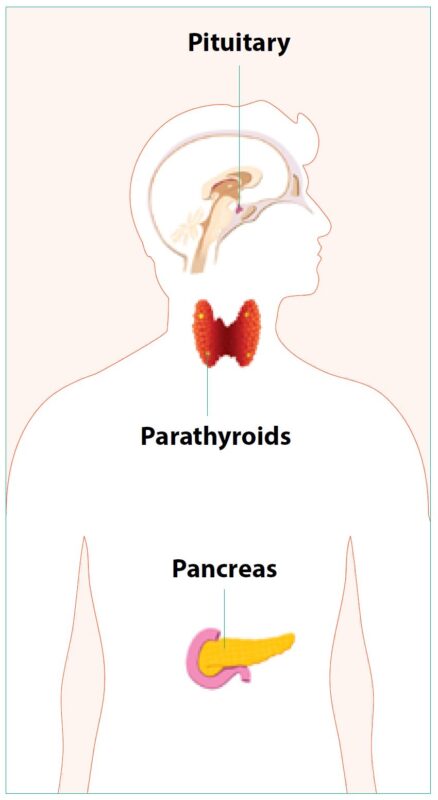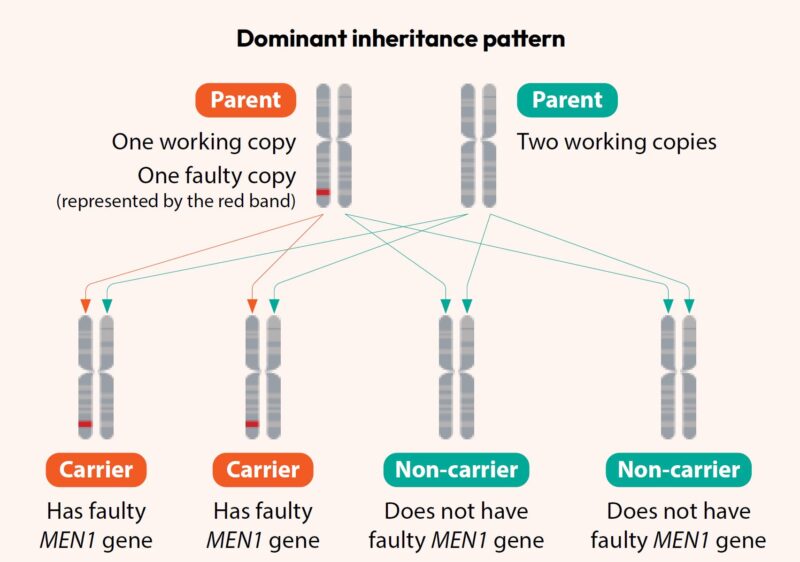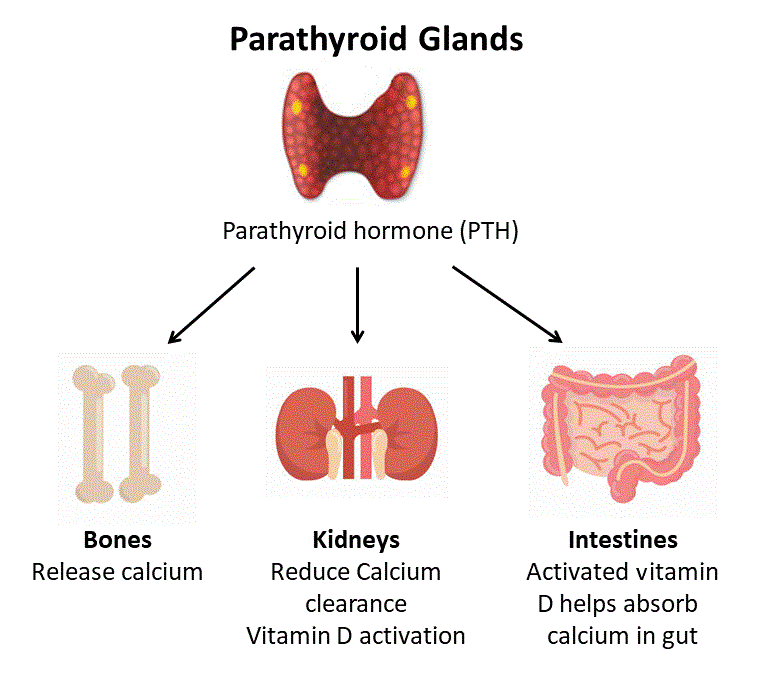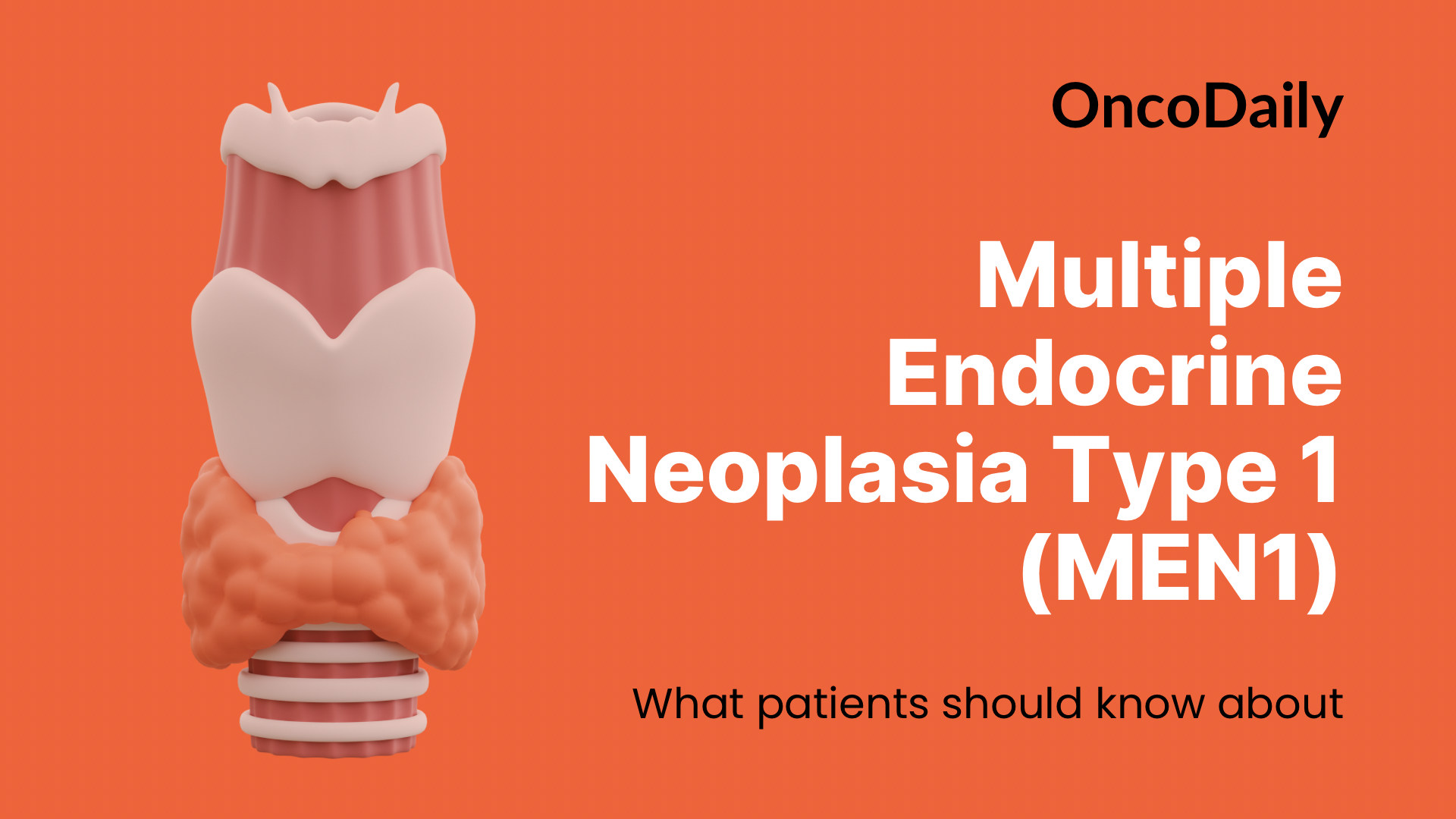Multiple Endocrine Neoplasia Type 1 (MEN1) is a rare genetic disorder that causes tumors to develop in the hormone-producing glands of the body, including the parathyroid, pancreas, and pituitary glands.Some tumors are noncancerous (benign), while others can become malignant (cancerous) over time.
This article will explain how MEN1 affects the body, its symptoms, how it is diagnosed, and treatment options. It will also cover genetic testing, family screening, myths about MEN1, and the latest research on future treatments. Understanding MEN1 can help patients manage their condition and make informed decisions about their health.

Is MEN1 Cancer?
MEN1 itself is not cancer, but it can cause tumors, some of which may become cancerous over time. MEN1 leads to the growth of multiple tumors in hormone-producing glands, such as the parathyroid, pancreas, and pituitary glands. Most of these tumors are benign (noncancerous), meaning they do not spread to other parts of the body. However, in some cases, MEN1 tumors can become malignant (cancerous), especially in the pancreas or digestive tract.
How Does MEN1 Affect the Body?
Multiple Endocrine Neoplasia Type 1 (MEN1) affects the body by causing tumors to grow in hormone-producing glands. These tumors can lead to hormonal imbalances, which may cause a variety of symptoms depending on which glands are affected.
The parathyroid glands, located in the neck, help regulate calcium levels in the blood. When MEN1 causes tumors in these glands, calcium levels become too high, leading to bone pain, kidney stones, fatigue, and stomach issues. The pancreas makes hormones like insulin and gastrin, which control blood sugar and digestion. MEN1 can cause pancreatic tumors that lead to low blood sugar (hypoglycemia), stomach ulcers, or severe acid reflux.
The pituitary gland, found at the base of the brain, controls many important hormones in the body. When MEN1 affects this gland, it can lead to problems with growth, fertility, and energy levels, causing symptoms like weight changes, headaches, or vision problems. While many of these tumors are noncancerous (benign), they still need medical attention because they can disrupt normal hormone function and cause long-term health issues. Regular monitoring and early treatment can help manage symptoms and improve quality of life for people with MEN1.
Causes and Risk Factors
Multiple Endocrine Neoplasia Type 1 (MEN1) is caused by a mutation in a specific gene called the
MEN1 gene. This gene normally helps control the growth of cells in hormone-producing glands. When the MEN1 gene is mutated, it causes tumors to grow in these glands, leading to the health problems associated with MEN1. Since MEN1 is a genetic condition, it is usually inherited from a parent who carries the mutated gene. If one of your parents has MEN1, you have a 50% chance of inheriting the condition. In some cases, MEN1 can occur without a family history of the disorder due to a new genetic mutation in the individual. Certain factors can increase the likelihood of developing MEN1, including:
- Family history: Having a parent or sibling with MEN1 increases your risk.
- Genetic mutations: If the MEN1 gene is altered, it can cause tumors to develop in various glands.
- Age: MEN1 often shows symptoms in early adulthood, though the condition may be diagnosed later in life.
Understanding the causes and genetic risk factors is important for managing MEN1. If you have a family history of MEN1 or suspect you may be at risk, it’s helpful to discuss genetic testing with your doctor to understand your chances of developing the condition

When to See a Doctor
You should see a doctor if you experience unexplained symptoms that could be linked to Multiple Endocrine Neoplasia Type 1 (MEN1). Early warning signs, such as persistent fatigue, bone pain, kidney stones, frequent stomach ulcers, or hormonal changes, may indicate that MEN1 is affecting your hormone-producing glands.
If you have a family history of MEN1, it’s important to talk to your doctor about genetic testing even if you don’t have symptoms yet. Since MEN1 is inherited, early screening can help detect the condition before serious complications develop. Also, if you notice sudden changes in blood sugar levels, unexplained weight loss or gain, severe acid reflux, or vision problems, don’t ignore them. These could be signs of tumors affecting the pancreas or pituitary gland.
MEN1 symptoms can appear gradually, but seeing a doctor early can help with diagnosis and treatment before serious complications occur. If something feels off, trust your instincts and get checked—early detection can make a big difference in managing MEN1 effectively.
How Is MEN1 Diagnosed?
Diagnosing Multiple Endocrine Neoplasia Type 1 (MEN1) involves a combination of genetic testing, blood tests, and imaging scans to check for hormone imbalances and tumor growth. Doctors may recommend:
- Genetic testing to detect mutations in the MEN1 gene.
- Blood tests to measure hormone levels.
- Imaging scans (MRI, CT, or ultrasound) to locate tumors in the parathyroid, pancreas, or pituitary glands.
Early diagnosis helps with better management and treatment of MEN1, especially for those with a family history of the condition.
Genetic Testing for MEN1
Genetic testing for Multiple Endocrine Neoplasia Type 1 (MEN1) helps determine if a person has a mutation in the MEN1 gene, which causes the condition. Since MEN1 is an inherited disorder, testing is especially important for people with a family history of the disease. The test is a simple blood test that looks for changes in the MEN1 gene. If the mutation is found, doctors can monitor for tumors early, even before symptoms appear. Family members of someone with MEN1 may also be tested to see if they carry the gene.
A positive result does not mean a person has cancer, but it does mean they have a higher risk of developing tumors in hormone-producing glands. If the test is positive, regular blood tests and imaging scans can help catch and treat problems early. If you have a family history of MEN1 or symptoms like high calcium levels, stomach ulcers, or hormone imbalances, genetic testing can provide important answers. Talking to a doctor or genetic counselor can help you decide if testing is right for you.
Blood Tests and Hormone Levels
Blood tests are an important tool for diagnosing and monitoring Multiple Endocrine Neoplasia Type 1 (MEN1). Since MEN1 causes tumors in hormone-producing glands, these tests help check for hormone imbalances that may signal a problem.Doctors may measure calcium and parathyroid hormone (PTH) levels to check for overactive parathyroid glands, which is often the first sign of MEN1.

High calcium levels can cause fatigue, kidney stones, and bone pain. Blood tests also check insulin, gastrin, and other pancreatic hormones to detect tumors in the pancreas. Imbalances in these hormones can lead to low blood sugar, stomach ulcers, or severe acid reflux. For pituitary gland tumors, doctors measure levels of hormones like prolactin, growth hormone, and cortisol, which affect metabolism, fertility, and overall health.
Imaging Tests to Detect Tumors
Since Multiple Endocrine Neoplasia Type 1 (MEN1) causes tumors in different hormone-producing glands, doctors use imaging tests to locate and monitor them. These tests help detect tumors in the parathyroid, pancreas, and pituitary glands, even before symptoms appear. Common imaging tests for MEN1 include:
- Ultrasound – Uses sound waves to check for parathyroid tumors in the neck.
- MRI (Magnetic Resonance Imaging) – Provides detailed images of the pituitary gland, pancreas, and other affected organs.
- CT Scan (Computed Tomography) – Helps detect tumors in the pancreas and nearby areas.
- Nuclear Medicine Scans – Specialized scans, such as a parathyroid scan, help find overactive parathyroid glands.
Treatment Options
The treatment for Multiple Endocrine Neoplasia Type 1 (MEN1) depends on the type and location of tumors. Common treatment options include:
- Surgery to remove tumors, especially in the parathyroid, pancreas, or pituitary glands.
- Medications to control hormone imbalances and manage symptoms.
- Radiation therapy to shrink tumors that cannot be surgically removed.
- Chemotherapy or targeted therapy for rare cases where tumors become cancerous.
Since MEN1 is a lifelong condition, regular monitoring and follow-up care are essential to detect and manage tumors early.
Surgery to Remove Tumors
Surgery is one of the main treatments for Multiple Endocrine Neoplasia Type 1 (MEN1) and is used to remove tumors that are causing health problems. The type of surgery depends on which glands are affected. If tumors grow in the parathyroid glands, surgery may be needed to remove one or more of them to lower high calcium levels and prevent complications like kidney stones and bone loss. This is one of the most common surgeries in MEN1 patients.
For pancreatic tumors, surgery may be recommended if they are producing too much insulin or gastrin, causing low blood sugar or severe stomach ulcers. Some pancreatic tumors can also become cancerous, so removing them early can help prevent spread. If tumors develop in the pituitary gland, surgery may be needed if they press on the brain or affect vision. These surgeries are often done with a minimally invasive approach, meaning a small incision is made inside the nose to remove the tumor without major surgery.
Surgery can help relieve symptoms and improve quality of life, but regular follow-up is important since MEN1 tumors can return over time. Early detection and monitoring can help doctors decide the best time for surgery to prevent complications.
Medication to Manage Hormone Levels
Since Multiple Endocrine Neoplasia Type 1 (MEN1) causes tumors that affect hormone production, medications are often used to help balance hormone levels and manage symptoms. These medicines do not cure MEN1, but they can control the effects of overactive glands and improve quality of life. If parathyroid tumors cause high calcium levels, doctors may prescribe medications like calcimimetics (such as Cinacalcet) to lower calcium and reduce symptoms like bone pain and kidney stones.
For pancreatic tumors, medications may be used to control insulin, gastrin, or other hormones. For example, proton pump inhibitors (PPIs) help reduce stomach acid caused by gastrin-producing tumors, preventing painful ulcers and acid reflux. If pituitary tumors affect hormone levels, medications like dopamine agonists (for prolactin-secreting tumors) or somatostatin analogs (for growth hormone tumors) can help regulate hormone production and reduce tumor size.
Because MEN1 is a lifelong condition, regular monitoring is important to adjust medications as needed. By managing hormone levels, these treatments can help prevent complications and improve daily well-being.
Radiation Therapy and Chemotherapy in Some Cases
For most people with Multiple Endocrine Neoplasia Type 1 (MEN1), surgery and medication are the main treatments. However, in rare cases where tumors become cancerous or cannot be removed with surgery, radiation therapy or chemotherapy may be needed.
Radiation therapy uses high-energy rays to shrink tumors and stop them from growing. It is sometimes used for pituitary tumors that cannot be completely removed with surgery or for other MEN1-related tumors that may be pressing on nearby organs. Chemotherapy is only used if a tumor becomes cancerous and spreads. It involves strong drugs that attack cancer cells throughout the body. While chemotherapy is not common in MEN1, it may be used for aggressive pancreatic neuroendocrine tumors (NETs) or other rare cases.
Since MEN1 is a lifelong condition, regular monitoring helps doctors decide if and when these treatments are necessary. Most MEN1 tumors are not cancerous, but in the rare cases when they are, radiation or chemotherapy can help slow the disease and improve quality of life.
Long-Term Management of MEN1
Since Multiple Endocrine Neoplasia Type 1 (MEN1) is a lifelong condition, regular monitoring and early treatment are essential to prevent complications and improve quality of life. Because MEN1 causes tumors in hormone-producing glands, ongoing care focuses on detecting new tumors early and managing hormone imbalances. Doctors recommend routine blood tests and imaging scans to check for tumor growth and changes in hormone levels. Medications may be needed to control calcium, insulin, or other hormones, while surgery may be necessary if tumors become too large or cause severe symptoms.
A healthy lifestyle, including a balanced diet, regular exercise, and avoiding smoking or excessive alcohol, can also support overall well-being. Patients with a family history of MEN1 should consider genetic testing and discuss screening options with their doctor. With regular medical care and early intervention, many people with MEN1 can lead active and fulfilling lives while managing their condition effectively.
Myths and Misconceptions About MEN1
Because Multiple Endocrine Neoplasia Type 1 (MEN1) is a rare genetic condition, there are many myths and misunderstandings about it. Knowing the facts can help patients and families better understand and manage the condition.
Myth 1: MEN1 Is a Type of Cancer
Fact: MEN1 itself is not cancer, but it causes tumors in hormone-producing glands. Most tumors are benign (noncancerous), but some, especially in the pancreas, can become cancerous over time. Regular monitoring helps detect and treat any changes early.
- MEN1 Only Affects Older Adults: MEN1 can develop at any age, though symptoms often appear in early adulthood. Since it is a genetic condition, doctors recommend screening family members who may be at risk, even if they have no symptoms yet.
- If You Feel Fine, You Don’t Need Regular Check-Ups: Many MEN1-related tumors develop slowly and may not cause symptoms right away. Regular blood tests and imaging scans are essential for early detection and treatment before serious complications occur.
- Surgery Cures MEN1: While surgery can remove tumors, MEN1 is a lifelong condition, and new tumors can still develop over time. Long-term monitoring and, in some cases, medications are needed to manage hormone levels and prevent complications.
- If a Parent Has MEN1, Their Child Will Definitely Get It: MEN1 is inherited, but a child of a parent with MEN1 has a 50% chance of inheriting the gene mutation. Genetic testing can help determine whether screening and early monitoring are needed.
Understanding MEN1 and staying informed about regular screenings, treatment options, and risk factors can help patients and their families take control of their health and well-being.
You Can Watch More on OncoDaily Youtube TV
Written by Toma Oganezova, MD
FAQ
What is Multiple Endocrine Neoplasia Type 1 (MEN1)?
MEN1 is a rare genetic disorder that causes tumors in hormone-producing glands, including the parathyroid, pancreas, and pituitary glands.
What are the common symptoms of MEN1?
Symptoms vary but may include high calcium levels, kidney stones, stomach ulcers, low blood sugar, fatigue, and hormonal imbalances.
Is MEN1 a type of cancer?
No, MEN1 itself is not cancer, but it can cause tumors, some of which may become cancerous over time, especially in the pancreas.
How is MEN1 diagnosed?
MEN1 is diagnosed through genetic testing, blood tests to check hormone levels, and imaging scans like MRI, CT, or ultrasound to detect tumors.
Can MEN1 be inherited?
Yes, MEN1 is a genetic condition passed from parent to child. A person with MEN1 has a 50% chance of passing it to their children.
What are the treatment options for MEN1?
Treatment depends on the affected glands and may include surgery, medications to balance hormones, radiation, or, in rare cases, chemotherapy.
How often should someone with MEN1 have check-ups?
Regular monitoring with blood tests and imaging scans is recommended, typically every 6-12 months, to detect and manage tumors early.
Can MEN1 be cured?
There is no cure for MEN1, but with proper medical management, symptoms can be controlled, and complications can be prevented.
What lifestyle changes can help manage MEN1?
Maintaining a balanced diet, regular exercise, stress management, and avoiding smoking or excessive alcohol can support overall health.
Should family members of someone with MEN1 get tested?
Yes, genetic testing is recommended for close family members to determine if they have inherited the MEN1 gene mutation.
